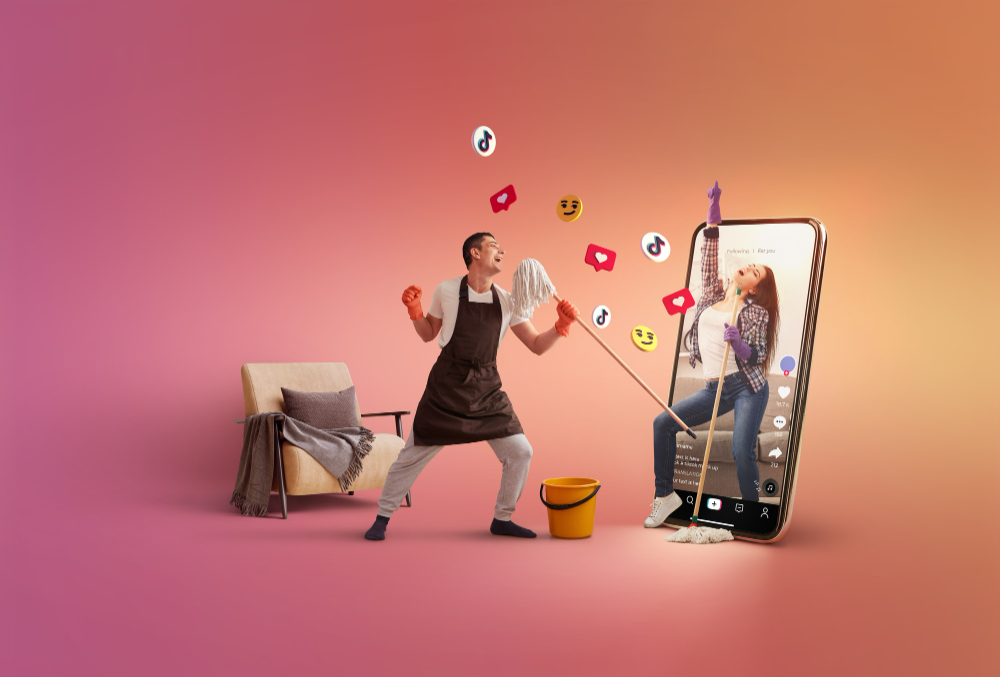
Social media refers to a form of online communication that enables people to create, share, and exchange information, ideas, and multimedia content with others through virtual communities and networks. It typically involves platforms and websites that allow users to create profiles, connect with others, and engage in various activities such as posting text, images, videos, and links, commenting, likes, and sharing content.
Social media has become an integral part of modern society, shaping how people communicate, share information, and interact with each other. It has transformed the way news is disseminated, how businesses market their products and services, how people express their opinions, and how social movements and activism are organized. However, social media also raises concerns about issues such as privacy, online harassment, misinformation, and the spread of fake news, and its impact on mental health and well-being.
How Social Media Work
Social media works by leveraging online platforms and websites to facilitate communication and interaction among users. Users typically create profiles on these platforms and connect with others, forming virtual communities and networks. They can then engage in various activities such as posting text, images, videos, and links, commenting, liking, and sharing content.
Social media platforms use algorithms and technologies to display content to users based on their interests, behaviors, and interactions. They enable users to follow or be followed by others, creating networks of relationships. Users can also engage in real-time conversations through features such as messaging, chat, and comments.
Social media also provides opportunities for businesses, organizations, and influencers to promote their products, services, or messages through targeted advertising and influencer partnerships. It has become a powerful tool for digital marketing and brand building, allowing businesses to reach and engage with their audiences in a more direct and interactive manner.
Example of Social Media
Facebook: Facebook is a social networking site that allows users to create profiles, connect with friends, share posts, photos, and videos, and engage in various activities such as liking, commenting, and sharing content. It is one of the largest and most widely used social media platforms globally.
Instagram: Instagram is a photo and video sharing platform that allows users to share visual content, apply filters, and engage with others through likes, comments, and direct messaging. It is particularly popular among younger audiences and is often used for sharing visual stories and showcasing lifestyle, fashion, and travel content.
Twitter: Twitter is a microblogging platform that allows users to share short messages called “tweets,” which can include text, images, and videos. It is known for its real-time nature and is often used for news updates, conversations, and discussions on various topics.
LinkedIn: LinkedIn is a professional networking platform that focuses on building professional connections, sharing work-related content, and exploring job opportunities. It is widely used by professionals, businesses, and job seekers for networking and career development.
YouTube: YouTube is a video-sharing platform that allows users to upload, watch, and share videos. It is popular for sharing a wide range of content, including entertainment, tutorials, educational content, and vlogs.
TikTok: TikTok is a short-form video platform that allows users to create and share short, often music-driven videos. It has gained immense popularity, particularly among younger audiences, for its creative and entertaining content.
Pinterest: Pinterest is a visual discovery platform that allows users to discover and save ideas for various topics such as fashion, food, home decor, and travel. It is known for its visual bookmarking and inspiration-based content.
Pros of Social Media
Connectivity: Social media enables people to connect and communicate with others around the world, fostering global connections and facilitating real-time communication with family, friends, and acquaintances. It allows people to maintain relationships, collaborate on projects, and share updates in a convenient and efficient manner.
Information Sharing: Social media platforms serve as a source of news, information, and educational content. They allow users to access a wide range of information on various topics, from news updates to educational resources, helping people stay informed, expand their knowledge, and learn from others.
Business and Marketing Opportunities: Social media provides businesses, organizations, and influencers with powerful marketing tools to promote products, services, or messages, and reach a global audience. It allows businesses to engage with customers, build brand awareness, and drive sales, while also providing a platform for entrepreneurs and small businesses to gain visibility and connect with potential customers.
Community Building: Social media allows users to form and join communities based on shared interests, hobbies, or causes, creating virtual spaces for like-minded individuals to connect, collaborate, and support each other. It fosters communities and social movements, enabling people to raise awareness, advocate for causes, and mobilize for positive change.
Creativity and Self-Expression: Social media platforms provide users with tools to express themselves creatively through various forms of content, such as posts, images, videos, and stories. It allows individuals to showcase their talents, share their perspectives, and express their creativity, fostering self-expression and individuality.
Entertainment and Leisure: Social media offers a wide range of entertainment options, including videos, games, memes, and other forms of content that can provide relaxation, amusement, and leisure. It allows users to access and share entertaining content, helping to relieve stress and provide a source of enjoyment.
Cons of Social Media
Misinformation and Fake News: Social media platforms can spread misinformation, fake news, and rumors quickly, leading to the spread of false information and misinformation that can have detrimental consequences on individuals, communities, and society at large. It can lead to confusion, polarizing opinions, and erode trust in reliable sources of information.
Cyberbullying and Online Harassment: Social media can be a breeding ground for cyberbullying, harassment, and online abuse. Users can face negative comments, threats, and harassment, leading to emotional distress, mental health issues, and even physical harm. Cyberbullying can have long-lasting effects on the well-being of individuals, particularly children and teenagers.
Privacy and Security Risks: Social media platforms often collect and store vast amounts of personal data, which can raise privacy concerns. Users’ personal information can be vulnerable to data breaches, identity theft, and misuse by malicious actors. Additionally, social media platforms may track users’ online behavior, leading to potential privacy violations and targeted advertising.
Addiction and Mental Health Issues: Social media can be addictive, leading to excessive use, and negatively impacting mental health. It can contribute to feelings of anxiety, depression, loneliness, and low self-esteem. The constant pressure to compare oneself to others and seek validation through social media can have detrimental effects on mental health and well-being.
Filter Bubbles and Echo Chambers: Social media algorithms often personalize content based on users’ preferences and behavior, leading to filter bubbles and echo chambers. This can create a narrow and biased view of the world, reinforcing existing beliefs and limiting exposure to diverse perspectives, leading to polarization and division.
Time-Wasting and Productivity Loss: Social media can be a time-consuming distraction, leading to reduced productivity and time wasted on mindless scrolling. It can interfere with work, study, and other important activities, leading to reduced efficiency and effectiveness.
Comparison and FOMO: Social media can contribute to a culture of comparison and fear of missing out (FOMO), where users compare their lives to others’ highlight reels, leading to feelings of inadequacy, envy, and low self-esteem.
What is FOMO
FOMO, or Fear of Missing Out, is a modern-day phenomenon encapsulating the anxiety of being excluded from social events or trends. In the digital age, social media amplifies this fear by showcasing others’ seemingly exciting experiences. This pervasive emotion often drives impulsive actions to stay connected, impacting mental well-being.
Understanding FOMO is crucial in navigating the digital landscape. Embracing mindfulness and focusing on genuine connections can alleviate its effects. Explore how to overcome FOMO and strike a balance between virtual and real-life experiences to foster a healthier, more fulfilling lifestyle. Don’t let FOMO dictate; create a life that truly resonates with you.
Future of Social Media
Augmented Reality (AR) and Virtual Reality (VR): AR and VR technologies are likely to become more integrated into social media platforms, enabling users to have immersive and interactive experiences. This could include virtual social events, virtual marketplaces, and augmented reality filters that enhance user-generated content.
Artificial Intelligence (AI): AI is expected to play a bigger role in social media, from personalized content recommendations to automated content creation and moderation. AI-powered chatbots and virtual assistants could enhance customer service and support on social media platforms.
Video and Live Streaming: Video content is already a dominant form of content on social media, and it is likely to continue growing in the future. Live streaming is also gaining popularity, providing real-time interaction and engagement opportunities for users.
Ephemeral Content: Ephemeral content, such as Stories, which disappear after a short time, has gained popularity on social media platforms. This trend is expected to continue, with more platforms incorporating ephemeral content and users seeking more authentic and real-time interactions.
Influencer Marketing: Influencer marketing is likely to continue growing as a form of advertising on social media, with brands partnering with influencers to promote their products or services to their engaged audiences.
Privacy and Security: As concerns about data privacy and security continue to rise, social media platforms are expected to focus on providing better privacy controls, data protection, and transparency in their policies and practices.
Niche and Interest-based Communities: Users are increasingly seeking specialized communities and interest-based groups on social media platforms, and this trend is expected to continue in the future. Niche communities and micro-influencers could gain more traction, providing opportunities for targeted engagement.
Social Commerce: Social media platforms are increasingly integrating e-commerce features, allowing users to shop directly from the platforms. This trend is expected to continue, with social commerce becoming a significant revenue stream for both platforms and businesses.
Conclusion
Social media works by providing online platforms that facilitate communication, interaction, and content sharing among users, shaping how people communicate, connect, and engage in the digital world. It has transformed various aspects of society, including communication, marketing, and activism, while also presenting challenges and concerns that need to be addressed for responsible and ethical use of social media.




Leave a Reply